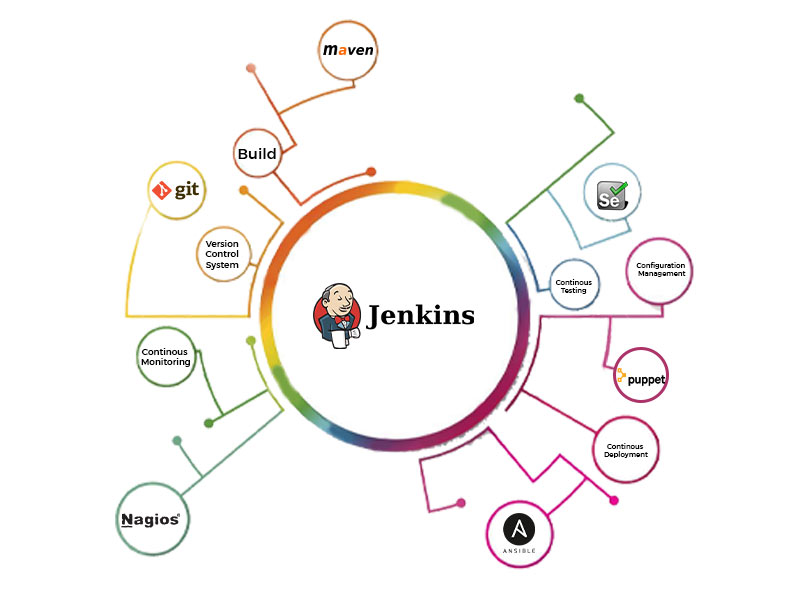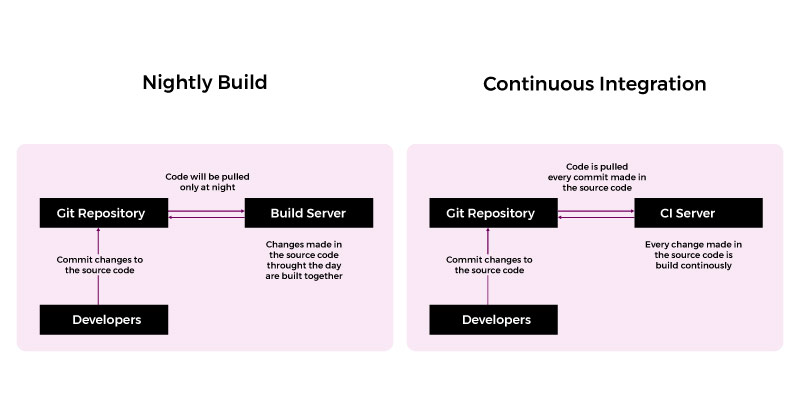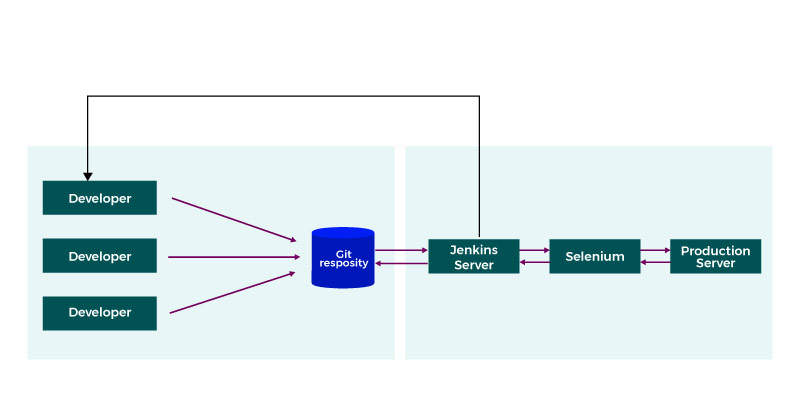
As everything becomes digitized and cloud-based infrastructure, the demand for DevOps engineers increases simultaneously. The market for DevOps engineers has risen to 25% compared to previous years. If you are intended to land your career in the IT sector, then becoming a DevOps engineer would provide you with plenty of job opportunities in many top IT companies. Predominantly, you can be part of SDLC. So, to become a DevOps engineer, you can join DevOps Training in Chennai and learn the DevOps Principles, DevOps Ecosystem, and tools that are used in DevOps.
According to the survey, there are more than one million devops engineers worldwide, and it is one of the highest-paying jobs in the IT industry. If you have skills, you will be paid around 5 to 6 lakhs per year in India. It is considered as a starting salary for freshers, but you will be paid more after gaining years of experience based on the skill and years of experience obtained.
In this blog, we shall discuss about the use of Jenkins, what is the requirement for using Jenkins, what is Jenkins tool, why DevOps is a demanding career, and why Jenkins is used.
Why Devops is a Demanding Career
In India, a DevOps engineer earns more than a data engineer, a data scientist, and many other IT professionals. In this industry, there is an excellent opportunity for Indian technology professionals. We've seen Indians have a lot of success in the digital market since they can provide highly skilled employees for various outsourcing platforms. Technologies have become one of the world's most profitable industries. Many freshers and young people are studying many other skills to differentiate themselves in the market as an excellent service providers.
Today, the software is at the core of every business. To be competitive, they must deliver new products and technology swiftly while maintaining security and governance. Engineering and operational teams use DevOps concepts to make software supply flexible, bug-free, and efficient. It's impossible to overestimate their impact on software delivery. DevOps is one of the most rapidly developing and innovative technological concepts today.
So far, we have discussed why DevOps is a demanding career and why it is a challenging career in the IT sector. Now, we shall discuss what is Jenkins tool, how to use Jenkins, and what is the requirement for using Jenkins.
DevOps course is particularly designed for the Bangalore based students who intended to begin their career as a DevOps engineers. So, interested students can join DevOps Training in Bangalore and learn the core concepts.
What is Jenkins, and what is the requirement for using Jenkins?
It is an automation tool written in Java programming language built on continuous integration. The Jenkin tool is used to test the software using the continuous integration process, which aids the developers in making changes to the process and helps to outsource valuable software products. Moreover, It also enables you to release your software processing continuously by integrating with various testing and deployment technologies.
Companies can use Jenkins to automate the software development process and shorten the processing time. Jenkins unifies many development life-cycle operations, such as creating, recording, verifying, packaging, deploying, debugging, etc.
In addition, Jenkins executes Continuous Integration with the aid of plugins. Plugins permit the integration of Different DevOps phases. If you intend to integrate any specific tool, you should install or deploy the plugin, for Examples include Git, Amazon Elastic Compute Cloud, Maven 2 project, Hypertext Markup Language, etc.
The below picture illustrates that Jenkins is incorporating various DevOps phases:

Advantages of Jenkins include
-
It is an open-source tool.
-
It can be deployed and installed instantly.
-
Moreover, it has 1000+ which helps work with.
-
Additionally, it is free of charge.
-
It is highly built-in by Java coding; therefore, it is flexible for all platforms.
-
The community handles and administers it and conducts a meeting to gather public input to make advancements and enhance the Jenkins project.
-
This meeting is held every month.
-
Further, Jenkin has over 1000 plugins that enable Jenkins to be more flexible and robust.
-
Predominantly, Jenkin tools can be utilized for cloud-based architecture. It helps the developer to install Jenkins on cloud-based platforms.
-
Most importantly, it is specifically designed for developers.
Disadvantages of using Jenkins
-
Compared to contemporary UI trends, its interface is outdated and not user-friendly.
-
Jenkins is popular among developers, but it's not easy to manage because it operates on a server and involves server administrator skills to monitor its activity.
-
The complexity of configuring Jenkins is one of the main reasons people do not use it.
-
Continuous integrations frequently fail because of insignificant setup modifications. Because continuous integration will be interrupted, some developer involvement will be expected.
-
So far, we have discussed Jenkins uses and why developers use Jenkins. Now, we shall discuss unique features that separate Jenkins from other continuous integration. Let us examine this from this point of view.
Jenkins Features
The following are a few attributes of Jenkins that make it more agreeable than other Continuous Integration tools:
-
Adoption: Jenkin is widely utilized by more than 150,000 active users. Due to its flexibility, it is actively deployed and installed by one million users globally.
-
Plugins: Jenkins is interconnected with well over 1,000 plugins that allow it to integrate with most of the development, testing, and deployment tools.
From the above point, we can comprehend that Jenkin is in high demand globally. Before we get started with Jenkins, it's important to understand what continuous integration is and why it's used.
Moreover, if you are interested in being a part of the software development process, then you choose DevOps Online Training, which provides equal emphasis for both online and offline classes.
What is Continuous Integration?
Continuous Integration is the process of continuously merging code updates from different developers in a single project. After a code commit, the software is instantly tested. Code is created and tested with each change. The code is then tested for deployment if the test passes. The code gets pushed to production if the deployment is successful.
This continuous process of submitting, creating, verifying, and deploying is known as continuous integration/deployment.
As a result, the teams are able to spot difficulties early on. Apart from that, the Continuous Integration tool can do a variety of other tasks, such as uploading the built application to the test server, informing the relevant teams about the development and test results, and so on.
Why Jenkins is used?
Jenkins is server-based software that works on Windows, Linux, macOS, Unix, and other platforms that use a web server such as Apache Tomcat. To use Jenkins, you must first build pipelines, a set of processes that a Jenkins server will carry out. Jenkins Continuous Integration Pipeline is a robust technology that includes tools for hosting, analyzing, generating, and evaluating code or code updates.
Now, we shall discuss tools that compile Jenkins Continuous Integration Pipeline.
Continuous Integration Server- Jenkins, GitLab CI, Bamboo, CircleCI, Buddy, TeamCity, Codeship, Semaphore, Spinnaker, etc.
Source Control Tool- Concurrent Versions System, Apache Subversion, GitHub, Global Information Tracker, GitLab, Mercurial, Perforce, Monotone ClearCase, and others
Build tools- Scala-oriented Build Tool, CMake, Terraform, Apache Ant, Apache Maven, Apache Continuum, Ivy, Gradle, etc.
Automation testing framework- Selenium, Cypress, Appium, Serenity, TestComplete, Robot Framework, WebdriverIO, UFT, EarlGrey, Appium, Cucumber, and others
Why use Continuous Integration with Jenkins?
Consider the scenario in which the software's complete source code was generated and then tested on a test server. It may be the ideal method for creating software, yet it has numerous faults. Now, we shall discuss them ideally.
-
The test results must be evaluated until the entire software has been built.
-
Developers would face difficulties in finding vulnerabilities because they need to examine the complete source code of the application.
-
This evaluation process may take time to evaluate, so It causes a decrease in the delivery of software.
-
Continuous feedback on code or design concerns, production failures, test status, and data delivery uploads was missing, resulting in a potential drop in product quality.
-
Because the entire procedure was done by hand, there was a higher chance of failure.
As a result, the delivery of the software process and the quality of the product will decrease. A solution was needed to deal with the problem where developers could continuously trigger a build and test for any change they made to the source code. In such a case, the Jenkin tools address the above-stated problem and simplify the process.
We shall look at how Jenkins makes the software testing life cycle simple and accessible. Moreover, if you are interested in the software testing process, you can take up Software Testing Course In Bangalore to have in-depth knowledge of testing methodology and techniques.
Before Jenkins
-
When Developers had accomplished their assigned coding jobs, they would submit their code all at once. Following that, the build is tested and deployed.
-
A single build can take many days, and code commits, and test cycles were infrequent.
-
Because the code was created all at once, some developers would have to wait until others finished coding before checking their builds.
-
Identifying, analyzing, and addressing errors for numerous commits would be difficult.
-
Because the code development and testing processes are manual, there are several opportunities for failure.
-
Once all of the errors have been repaired and tested, the code is deployed.
-
The development cycle is lengthy.
After Jenkins
-
As soon as the Developer enters code, it gets built and tested. Throughout the day, Jenkin will develop and test code several times.
-
Jenkins will deliver the code to the test server and alert the deployment team if the development is successful.
-
If the deployment fails, Jenkins will alert the developer team of the errors.
-
After the Developers submit it, the code is built instantly.
-
Because the code is generated after every single developer's change, it's simple to figure out whose code caused the build to fail.
-
Build and test processes are automated, saving time and decreasing problems.
-
After each successful building and testing, the code is deployed.
-
The development process moves quickly.
-
Moreover, users have easier access to new functionality, and Profits are increased.
Continuous Integration in the Real World
I'm sure that you've all used Nokia phones at some point in your lifetimes. A process known as Nightly builds was used in a Nokia software product development project. Continuous Integration can be considered as a precursor to nightly builds. It implies that every night, an automatic system downloads and builds the code that was updated to the shared repository over the day. The concept is similar to Continuous Integration, but the code was built at night, and finding and correcting errors was a major challenge. Nokia implemented Continuous Integration as a result of this (CI). As a result, every change to the repository's source code was built.

Jenkins Plugins and how to use Jenkins?
Moreover, Jenkins offers a specific set of functionalities by default. So, you will need to install Git-related plugins if you wish to combine your Jenkins setup with versioning technologies like Git. In fact, you'll need to install plugins in Jenkins to integrate with programs like Maven and Amazon EC2.

Why Jenkins is used, and what is the requirement for using Jenkins?
-
After a source commit, Continuous Integration develops and tests the app right away.
-
Jenkins is a software project management tool that instigates a series of tasks for Continuous Integration.
-
When all Developers had finished their allotted coding assignments before Jenkins, they used to submit their code all at once. Build is then verified and installed.
-
As soon as the developer submits code, Jenkins builds and tests it. Moreover, Throughout the day, Jenkin will build and test code several times.
-
Jenkins provides a specific set of functionalities by default.
-
You will need to install Git-related plugins to combine your Jenkins deployment with version control technologies like Git.
Now, you would have understand why Jenkins is used, Jenkins uses, what is Jenkins tool and how to use Jenkins. So, to learn more about the Jenkins, you can join DevOps training in Chennai to have a comprehensive understanding of Jenkins automation server, software development, and testing, e.g., code, documentation, localization, blog posts, meetups, etc.